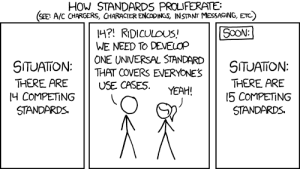An important issue in the IoT industry is the plethora of IoT standards that exist today and new standards being created. The current situation for IoT standards has been described as a ‘Trainwreck for IoT Vendors‘ and the implication being IoT solutions are going to be pretty dumb. In the recent IoT Developer Survey, interoperability was one of the top concerns, so it is definitely been on the minds of IoT developers.
If we look at why there are so many IoT standards, there are many answers. The simple fact is that all standards are not created equal and some solve very different problems. Many of the different standards exist at different layers of the stack; just like the Internet. There is also lot of innovation required in the IoT industry to enable many of the use cases, for example, LPWAN. We also have to remember IoT is not new. Lots of industries have have massive investments in equipment that uses an existing standard that isn’t going away anytime soon.
Those are some of the valid reasons for the different IoT standards. Of course, they are many not great reasons; as the saying goes ‘standards are like toothbrushes, everyone wants to use one but not other peoples’. XKCD captures the spirit of the worst possible situation for a new IoT standard.

It is time we accept there will be a plethora of IoT standards. Some will become more widely adopted than others, some will fail but we will never get to the ‘one IoT standard to rule them all’. It is just not realistic.
However, we still need to solve the issue of interoperability. There are many use cases of Things/Devices that communicate using different standards but will need to communicate in a consistent manner. It seems to me the only way this interoperability challenge will be solved is in software and ideally open source software. We need an open software platform that enables the standards bazaar and not try to create a cathedral. Kai Kreuzer, Eclipse SmartHome project leader, has published a great video on this topic for Home Automation.
Interoperability is not going to be solved in standards groups. It is going to be solved with running software. Open source IoT platforms are going to be the bedrock for the IoT industry. There is just no other way it will work.
I agree. I just want simple TCP/UDP connection to the things in my home, be able to quickly write own scripts on one or few computers at home or on my own server, or phone, and I do not want to relay on the cloud. Some form of discovery, identification and encryption/authentication that is not prioritary is a must too. I fail to see why we need to invent entirly new stack of protocols, when we can reuse some of the existing one, that operate over every network already.
My view is that (IoT) interoperability will be sovled by both open standards and open source. Both sides need each other. Open standards (without code) do not solve interoperability at all. Similarly, an open source implementations for proprietary interfaces do not solve interoperability, but create another silo. For example, some IoT open source projects “reinvent” locations, i.e., handle geospatial information using their own way (e.g., without considering coordinate reference systems).
Open standards needs “kick ass” implementations of the standards to make interoperability a reality. And in fact, open standards enable open source software to compete with proprietary software. Like today’s web, there are open source implementations (both browser and server) and proprietary ones. And they interoperate, because open standards from W3C, OASIS and OGC (for the Geospatial Web).
This is the reason we proposed Eclipse Whiskers project (https://projects.eclipse.org/projects/iot.whiskers), a marriage of open IoT standards (the OGC SensorThings API) and open source. We believe it’s a powerful combination.